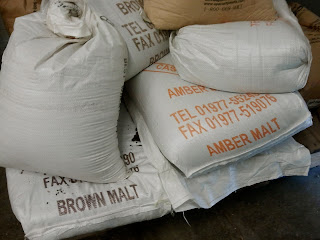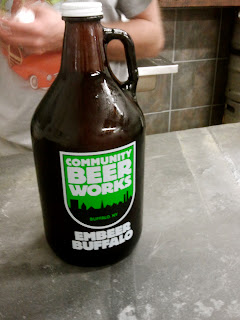Long time home brewers, Ethan, Dan and Rudy and the rest of the team of brewers were inspired by the growing popularity of professional nano breweries sprouting all over the US, like San Diego's Hess, to start one up here in Buffalo.
Currently, C.B.W creates two brews. Frank and the Whale. Pictured to the left in a glass and growler is Frank, an American Pale Ale with 4.6% abv.
"We start with a mellow malt base to showcase the hops against a lightly grainy sweetness. Zeus, Centennial and Zythos hops are used in the boil and again in dry hopping to maximize hop aroma and flavor. The result is a superbly drinkable Pale Ale loaded with zest, pine, and a touch of citrus."
A pretty good description though I would add that it was akin to chewing on a really good grilled steak, every bite making you want another one...and another...and another...
EMPTY GROWLER?! How did that happen?

Generally we do a double batch every brewday, filling up two of our conical fermenters. We have six of them, which is the limiting factor for our capacity: we could brew night and day, but you have to have somewhere to put it.
We have two 3 bbl brite tanks on order, which will increase our capacity by 2/3: after a double batch is done fermenting we can put it in one of our brite tanks for clarification and carbonation while we brew another batch. (They came in recently and are pictured below and to the right.)
Our clarification methods start and end with crash cooling the beer to drop the yeast out of suspension. We do not filter or use clarifying agents on our beer, which leaves in more nutrients and keeps it vegetarian." The addition of irish moss to the boil and whirlpooling allows for the partial removal of cold break before the wort is transfered to the fermenter, both which clarifies the beer. The yeast is racked to clarify the beer further.
These two fermenters sit in a cold room doing a great deal of their work in the dark. Besides these there are six 1.5 bbl stainless conical fermenters, which are all primary fermenters, though they have been doing single tank fermentation so far.
 This helps brewers to get the most out of their beer at this stage, maturing the beer to create a beautiful full flavored brew. The tubes shown here help some of the CO2 blow off to relieve the pressure.
This helps brewers to get the most out of their beer at this stage, maturing the beer to create a beautiful full flavored brew. The tubes shown here help some of the CO2 blow off to relieve the pressure.These SMT brite tanks with GW Kent valves mean that six more barrels of beer can be put into production. These tanks will clarify, condition, and carbonate the beer once they are all hooked up and ready to go. They are double insulated and glycol lined, meaning they will be able to cool the beer quicker and more efficiently.
The tanks stand as sentinels against the south wall waiting to be installed. Increasing production will allow for more delicious beer to be distributed throughout the area's bars, pubs and restaurants which really boils down to more opportunities to get tipsy on some outstanding Buffalo suds.
In regards to what exactly separates a nano from a micro brewery, no solid definition exists. Though how small a brewery has to be to qualify as nano has grown popular enough to attract federal regulator's attention. Leading the Alcohol Tax and Trade Bureau a few years back to issue a friendly but firm reminder to homebrewers looking to go pro that their efforts would lose tax exempt status after 100 gallons of production per year. Unofficial designations suggest systems of one-half to two barrels in size qualify as nano. So Community Beer Works currently falls neatly under this definition of nano with room to grow into a micro.
What is unique about C.B.W. is their commitment to quality and consistency, which can sometimes be a difficult thing to achieve when small batching. They also have retained their fanboy impishness without loosing sight of the beer and their fans, and it's that charming combination that keeps beer lovers like me coming back for more.









No comments:
Post a Comment